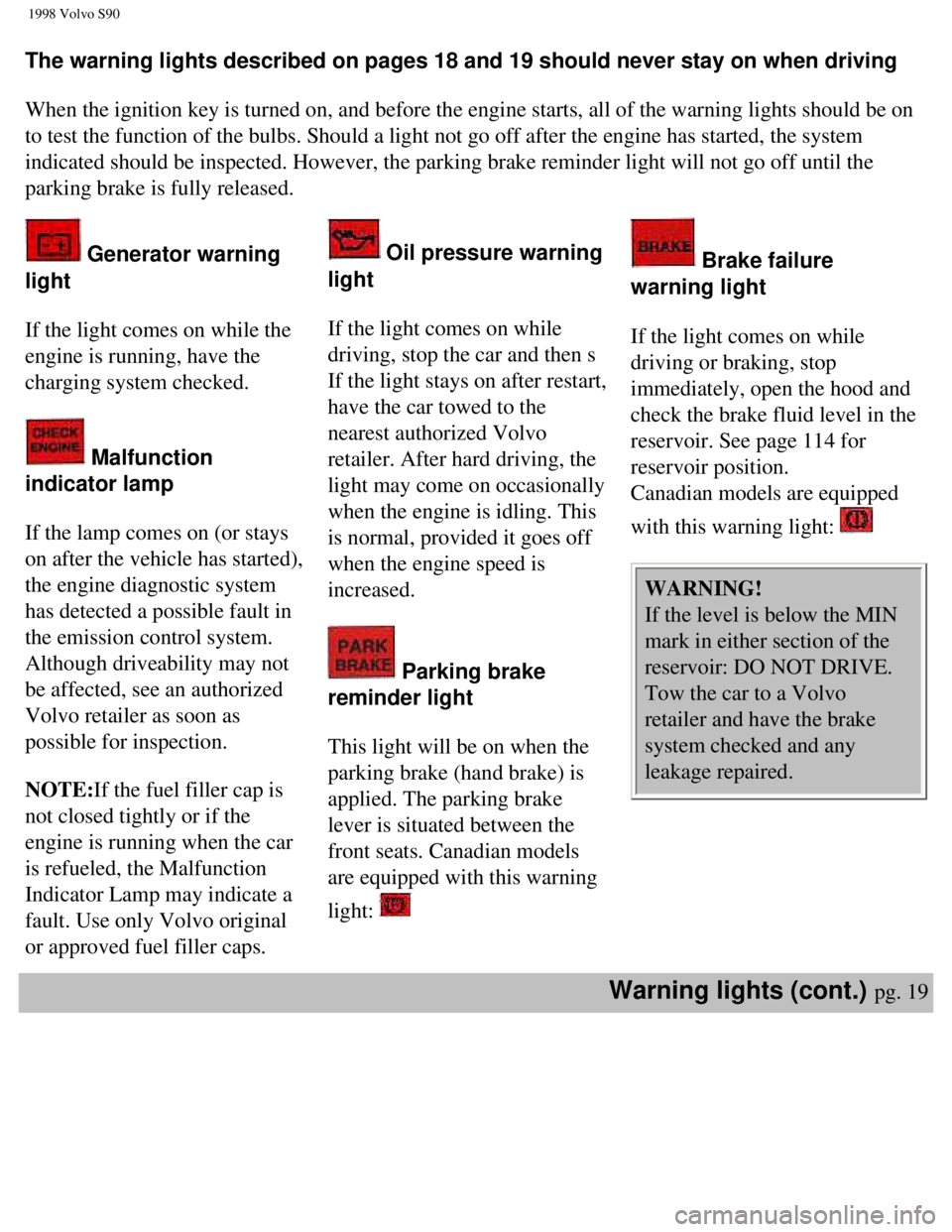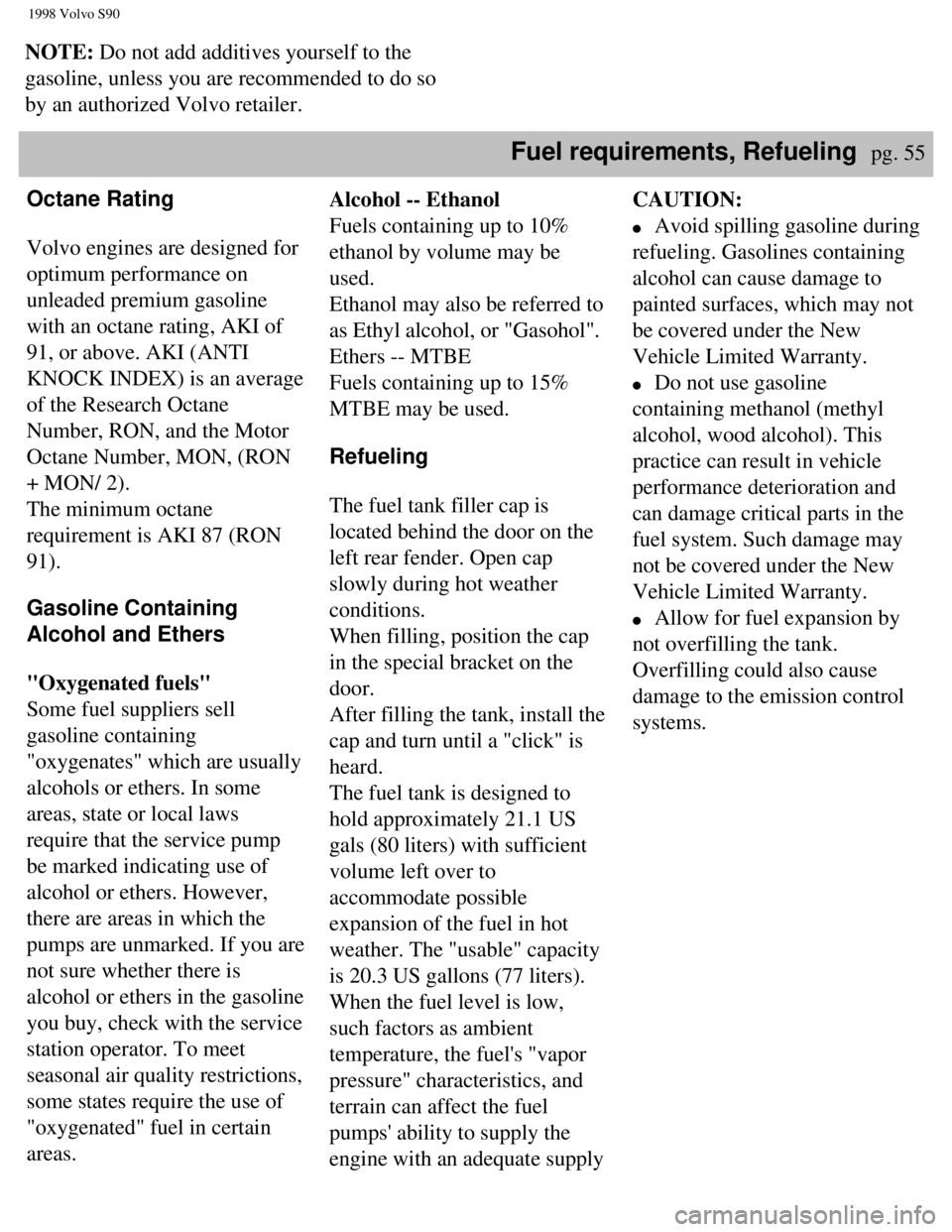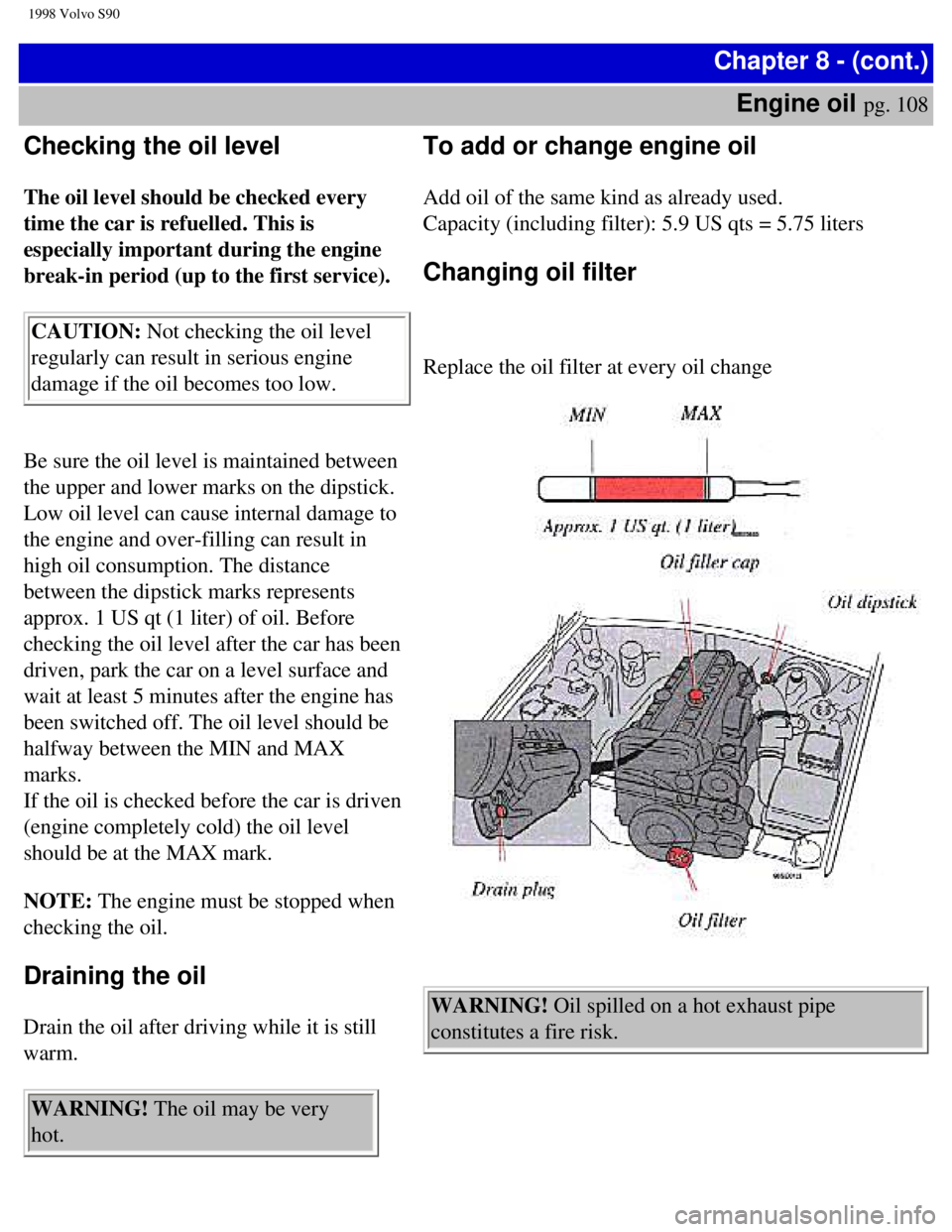1998 VOLVO V90 fuel cap
[x] Cancel search: fuel capPage 24 of 175

1998 Volvo S90
NOTE: Canadian model
speedometers/odometers
indicate kilometers only.
1 Ambient temperature
indicator (certain models)
Indicates the temperature
slightly above the surface of the
road. An amber warning lamp
lights up when the temperature
is in the range of 23-36° F (-5 -
+ 2° C). At low speeds or when
the car is not moving, the
temperature readings may be
slightly higher than the actual
ambient temperature due to heat
generated by the engine.
2 Fuel gauge
The total fuel tank capacity is
approx. 21.1 US gal. (80 liters).
The "usable" capacity is 20.3
US gal. (77 liters). When the
warning light comes on, there
are approximately 1.6 US gal. (6
liters) of fuel remaining in the
tank. See "Refueling" for further
information.3 Quartz crystal clock/
clock set button
Press the button and turn to set
the clock.
4 Speedometer
5 Odometer
6 Trip odometer/reset
button
Used for measuring shorter
distances. The last digit
indicates 1/10 mile/kilometer.
7 Tachometer
Reads thousands of engine rpm.
Engine should not be operated
in red range.
8 Temperature gauge
Do not drive the car with the
pointer in the red range. The
pointer should be approximately
midway on the gauge face when
driving. If the pointer approaches
the red range repeatedly, check
coolant level. See page 118.
WARNING! Allow engine to
cool before adding coolant.
Contents | Top of Page
file:///K|/ownersdocs/1998/1998_SV90/98S90_014.htm (3 of 3)12/30/2006 \
1:52:36 PM
Page 26 of 175

1998 Volvo S90
The warning lights described on pages 18 and 19 should never stay on whe\
n driving
When the ignition key is turned on, and before the engine starts, all of\
the warning lights should be on
to test the function of the bulbs. Should a light not go off after the e\
ngine has started, the system
indicated should be inspected. However, the parking brake reminder light\
will not go off until the
parking brake is fully released.
Generator warning
light
If the light comes on while the
engine is running, have the
charging system checked.
Malfunction
indicator lamp
If the lamp comes on (or stays
on after the vehicle has started),
the engine diagnostic system
has detected a possible fault in
the emission control system.
Although driveability may not
be affected, see an authorized
Volvo retailer as soon as
possible for inspection.
NOTE:If the fuel filler cap is
not closed tightly or if the
engine is running when the car
is refueled, the Malfunction
Indicator Lamp may indicate a
fault. Use only Volvo original
or approved fuel filler caps.
Oil pressure warning
light
If the light comes on while
driving, stop the car and then s
If the light stays on after restart,
have the car towed to the
nearest authorized Volvo
retailer. After hard driving, the
light may come on occasionally
when the engine is idling. This
is normal, provided it goes off
when the engine speed is
increased.
Parking brake
reminder light
This light will be on when the
parking brake (hand brake) is
applied. The parking brake
lever is situated between the
front seats. Canadian models
are equipped with this warning
light:
Brake failure
warning light
If the light comes on while
driving or braking, stop
immediately, open the hood and
check the brake fluid level in the
reservoir. See page 114 for
reservoir position.
Canadian models are equipped
with this warning light:
WARNING!
If the level is below the MIN
mark in either section of the
reservoir: DO NOT DRIVE.
Tow the car to a Volvo
retailer and have the brake
system checked and any
leakage repaired.
Warning lights (cont.) pg. 19
file:///K|/ownersdocs/1998/1998_SV90/98S90_017.htm (2 of 7)12/30/2006 \
1:52:36 PM
Page 62 of 175

1998 Volvo S90
NOTE: Do not add additives yourself to the
gasoline, unless you are recommended to do so
by an authorized Volvo retailer.
Fuel requirements, Refueling pg. 55
Octane Rating
Volvo engines are designed for
optimum performance on
unleaded premium gasoline
with an octane rating, AKI of
91, or above. AKI (ANTI
KNOCK INDEX) is an average
of the Research Octane
Number, RON, and the Motor
Octane Number, MON, (RON
+ MON/ 2).
The minimum octane
requirement is AKI 87 (RON
91).
Gasoline Containing
Alcohol and Ethers
"Oxygenated fuels"
Some fuel suppliers sell
gasoline containing
"oxygenates" which are usually
alcohols or ethers. In some
areas, state or local laws
require that the service pump
be marked indicating use of
alcohol or ethers. However,
there are areas in which the
pumps are unmarked. If you are
not sure whether there is
alcohol or ethers in the gasoline
you buy, check with the service
station operator. To meet
seasonal air quality restrictions,
some states require the use of
"oxygenated" fuel in certain
areas.
Alcohol -- Ethanol
Fuels containing up to 10%
ethanol by volume may be
used.
Ethanol may also be referred to
as Ethyl alcohol, or "Gasohol".
Ethers -- MTBE
Fuels containing up to 15%
MTBE may be used.
Refueling
The fuel tank filler cap is
located behind the door on the
left rear fender. Open cap
slowly during hot weather
conditions.
When filling, position the cap
in the special bracket on the
door.
After filling the tank, install the
cap and turn until a "click" is
heard.
The fuel tank is designed to
hold approximately 21.1 US
gals (80 liters) with sufficient
volume left over to
accommodate possible
expansion of the fuel in hot
weather. The "usable" capacity
is 20.3 US gallons (77 liters).
When the fuel level is low,
such factors as ambient
temperature, the fuel's "vapor
pressure" characteristics, and
terrain can affect the fuel
pumps' ability to supply the
engine with an adequate supply CAUTION:
l Avoid spilling gasoline during
refueling. Gasolines containing
alcohol can cause damage to
painted surfaces, which may not
be covered under the New
Vehicle Limited Warranty.
l Do not use gasoline
containing methanol (methyl
alcohol, wood alcohol). This
practice can result in vehicle
performance deterioration and
can damage critical parts in the
fuel system. Such damage may
not be covered under the New
Vehicle Limited Warranty.
l Allow for fuel expansion by
not overfilling the tank.
Overfilling could also cause
damage to the emission control
systems.
file:///K|/ownersdocs/1998/1998_SV90/98S90_053.htm (3 of 6)12/30/2006 \
1:52:41 PM
Page 71 of 175

1998 Volvo S90
disconnected, the code must
be re-entered before the radio
will function properly.
Points to remember pg. 62
Weight distribution affects
handling
At the specified curb weight
your car has a tendency to
understeer, which means that the
steering wheel has to be turned
more than might seem
appropriate for the curvature of
a bend. This ensures good
stability and reduces the risk of
rear wheel skid. Remember that
these properties can alter with
the vehicle load. The heavier the
load in the trunk, the less the
tendency to understeer.
Handling, roadholding
Vehicle load, tire design, and
inflation pressure, all affect
vehicle handling. Therefore,
check that the tires are inflated
to the recommended pressure
according to the vehicle load.
See "Tire pressure" section.
Loads should be distributed so
that capacity weight or
maximum permissible axle loads
are not exceeded.
WARNING!
An extra mat on the driver's
floor can cause the
accelerator pedal to catch.
Check that the movement of
the accelerator pedal is not
impeded. Not more than one
protective floor covering may
be used at one time.
CAUTION: Drive slowly and
carefully if going through
standing water (i.e. flooded
roadways, etc.). Damage to
engine could result if excess
water is ingested through the air
intake system. Never drive the
vehicle in water deeper than 1
foot (300 mm). See the flood
warning on page 7.
WARNING! Do not drive
with trunk lid or tailgate
open!
Poisonous exhaust gases may
enter via the trunk lid or
tailgate.
If the trunk lid/tailgate must
be kept open for any reason,
proceed as follows:
l Close the windows.
l Set the ventilation system
Roof rails/racks
Roof rails are standard
equipment on wagon models.
Load bars are available as a
retailer installed option on the
sedan models. Observe the
following points when is use:
l Avoid single-point loads.
Distribute the load evenly.
l Place heavier cargo at bottom
of load.
l Observe that center of gravity
and handling are influenced by
load weight.
l Increasing load size increases
wind resistance and, thus,
adversely affects fuel economy.
l Anchor the cargo correctly
with appropriate tie-down
equipment.
l Drive carefully. Avoid rapid
starts, fast cornering and hard
braking.
l Max. roof load is 220 lbs.
(100 kg) for removable racks.
For permanent roof racks, check
the manufacturers weight
specifications.
file:///K|/ownersdocs/1998/1998_SV90/98S90_058.htm (6 of 7)12/30/2006 \
1:52:42 PM
Page 80 of 175

1998 Volvo S90
cold-weather oil for hard driving or in warm
weather. See section "Engine oil" for more
information.
l The load placed on the battery is greater during
the winter since the heater, windshield wipers,
lighting etc. are used more often. Moreover, the
capacity of the battery decreases as the
temperature drops. In very cold weather, a poorly
charged battery can freeze and be damaged. It is
therefore advisable to check the state of charge
more frequently and spray an anti-rust oil on the
battery posts.
l Volvo recommends the use of snow tires on all
four wheels for winter driving - see section
"Wheels and tires".
l To prevent the washer reservoir from freezing,
add washer solvents containing antifreeze. This is
important since dirt is often splashed on the
windshield during winter driving, thus requiring
frequent use of the washers and wipers.
functions when the transmission is in reverse.
Also see "Winter/Wet" mode on page 59.
Winter/Wet mode
Enhanced Vehicle Traction
This mode may be selected for starting/moving
off on slippery roads or to lower downshift speeds
if the transmission is in "L".
Mode W
*In position D, the gearbox starts in third gear and
changes up to fourth gear.
*In position 3, second gear is locked and there is
no change up to third gear. In position L, first gear
is locked.
*These positions always offer the kick-down
feature.
Long distance trip pg. 70
Before a long distance trip
It is always worthwhile to have your car checked at a Volvo retailer
before driving long distances. Your retailer will also be able to supply\
you with bulbs, fuses, spark plugs and wiper blades for your use in the \
event that problems occur.
If you prefer to check the car yourself, please note the following:
l Check that the engine runs smoothly and that fuel consumption is
normal.
l Check engine oil, coolant levels, and for possible fuel leakage.
l Check transmission oil level and rear axle for leakage.
l Check condition of drive belts.
l Check state of charge of battery.
l Examine tires carefully (the spare tire as well), and replace those
that are worn. Check tire pressures.
l The brakes, front wheel alignment, and steering gear should be
checked by your Volvo retailer only.
l Check all lights, including high beams.
file:///K|/ownersdocs/1998/1998_SV90/98S90_067.htm (4 of 5)12/30/2006 \
1:52:43 PM
Page 119 of 175

1998 Volvo S90
Chapter 8 - (cont.)Engine oil
pg. 108
Checking the oil level
The oil level should be checked every
time the car is refuelled. This is
especially important during the engine
break-in period (up to the first service).
CAUTION: Not checking the oil level
regularly can result in serious engine
damage if the oil becomes too low.
Be sure the oil level is maintained between
the upper and lower marks on the dipstick.
Low oil level can cause internal damage to
the engine and over-filling can result in
high oil consumption. The distance
between the dipstick marks represents
approx. 1 US qt (1 liter) of oil. Before
checking the oil level after the car has been
driven, park the car on a level surface and
wait at least 5 minutes after the engine has
been switched off. The oil level should be
halfway between the MIN and MAX
marks.
If the oil is checked before the car is driven
(engine completely cold) the oil level
should be at the MAX mark.
NOTE: The engine must be stopped when
checking the oil.
Draining the oil
Drain the oil after driving while it is still
warm.
WARNING! The oil may be very
hot.
To add or change engine oil
Add oil of the same kind as already used.
Capacity (including filter): 5.9 US qts = 5.75 liters
Changing oil filter
Replace the oil filter at every oil change
WARNING! Oil spilled on a hot exhaust pipe
constitutes a fire risk.
file:///K|/ownersdocs/1998/1998_SV90/98S90_108.htm (1 of 6)12/30/2006 \
1:52:49 PM
Page 121 of 175

1998 Volvo S90
extreme operating conditions such as trailer
towing in sustained ambient temperatures over
104° F (40° C). However, SAE 10W-30 synthetic
oil would be a better alternative in such
conditions.
SAE 15W-40 should not be used under normal
operating conditions.
American Petroleum Institute
(API) labels. These labels certify
the oil conforms to the applicable
standards and specifications of
the API.
Servicing pg. 110
Torque exhaust and
intake manifold nuts
A loose manifold could alter air/
fuel ratio and cause an increase
in emissions and/or poor
driveability.
Air cleaner
Replace the air cleaner cartridge
with a new one every 30,000
miles (48,000 km). The
cartridge should be replaced
more often when driving under
dirty and dusty conditions, The
filter cannot be cleaned and,
therefore, should always be
replaced with a new one.
Vacuum fittings, hoses
and connections
Unstable idle, misfiring, or poor
emission control is often caused
by leaking vacuum hoses or
connections. Check hoses and
connections on distributor
vacuum unit, connections on
heater control servo systems and
hydraulic brake servo.
Fuel system cap, tank
and lines, and
connections
The effectiveness of the fuel
system to contain hydrocarbons
is dependent largely on a
leakfree system. Check for
proper sealing of gasoline filler
cap which contains "O" ring-
type seals. Check all
evaporative hoses in vehicle for
tightness. Check fuel lines under
vehicle and repair if necessary.
Fuel (line) filter
The fuel line filter is located
next to the fuel pump. This filter
should be replaced every
100,000 miles (160,000 km).
The filter is replaced as one
complete unit.
Replace more frequently if
contaminated fuel is introduced
into the tank (or if there is
reason to suspect that this has
occurred).
Timing belt
WARNING!
The distributor ignition
system operates at very high
voltages. Special safety
precautions must be followed
to prevent injury.
Always turn the ignition off
when:
l Replacing distributor
ignition components e.g.
plugs, coil, etc.
l Do not touch any part of
the distributor ignition system
while the engine is running.
This may result in unintended
movements and body injury.
Replacing spark plugs
The spark plugs should be
changed every 30,000 miles
(48,000 km). However, city
driving or fast highway driving
may necessitate changing after
15,000 miles (24,000 km) of
driving. When installing new
plugs, be sure to fit the right type
file:///K|/ownersdocs/1998/1998_SV90/98S90_108.htm (3 of 6)12/30/2006 \
1:52:49 PM
Page 122 of 175

1998 Volvo S90
Idle air control system
Your Volvo is equipped with an
electronically-controlled idle air
control system that requires no
checking or adjustment.
Volvo recommends that the
timing belt be replaced every
70,000 miles (112,000 km).
PCV system
The orifice nipple in the intake
manifold and the filter at the
end of the PCV hose in the
aircleaner should be inspected
every 60,000 miles (96,000 km).
Check/replace rubber hoses at
the same time.
and use correct torque, see
Specifications. When changing
the plugs, check that the
suppressor connectors are in
good condition. Cracked or
damaged connectors should be
replaced.
When changing the spark plugs,
clean the terminals and the
rubber seals.
Battery maintenance pg. 111
Battery maintenance
Driving habits and conditions, climate, the
number of starts, etc. all affect the service life and
function of the battery. In order for your battery to
perform satisfactorily, keep the following in mind:
l Check the fluid level in the battery every 6
months or every 10,000 * miles (16,000 km).
The fluid level in each battery cell should be
checked - use a screw driver to open the caps and
a flashlight to inspect the level.
*More frequently in warm climates.
l If necessary, add distilled water to
approximately 0.4 in. (10 mm) above the plates in
the cell or to the level indicator. See the
illustrations above.
l Check that the battery cables are correctly
connected and properly tightened.
l Never disconnect the battery when the engine is
running, for example when changing the battery.
l The battery should be disconnected when a
boost charger is used.
l Switch off the radio before disconnecting the
battery. If your radio has an antitheft code and the
battery is disconnected, the radio code has to be
reentered in order for the radio to function.
Fuel/emissions systems pg. 112
file:///K|/ownersdocs/1998/1998_SV90/98S90_108.htm (4 of 6)12/30/2006 \
1:52:49 PM